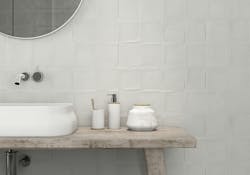What's the Difference Between Ceramic Tile and Porcelain?
Prized for its durability, porcelain tile is frequently specified as a high-performance surfacing. But the product is often mistakenly treated as interchangeable with ceramic tile, and that can lead to problems.
What is the difference between porcelain and ceramic tile? This is one of the most common questions tile people get, says tile guy Ryan Fasan.
“Porcelain is the common moniker for the ‘impervious’ technical category of tile,” says Fasan, the technical consultant and speaker for Tile of Spain USA. "Essentially, a porcelain or impervious tile is any ceramic tile that has less than 0.5 percent water absorption or available porosity.”
Both porcelain and ceramic tiles start almost the same, says Ceramics of Italy.
Porcelain vs Ceramic Tile
“Ceramic contains a mixture of clay, sand, and other natural materials that are formed into a desired shape and size and then fired at a high temperature,” Ceramics of Italy writes. “Porcelain is a type of ceramic with a compact, hard, and non-porous body. After mixing the raw materials with water, the mixture is compressed with a machine applying thousands of tons of pressure and fired in a kiln at a higher temperature than ceramic (roughly 1,200 to 1,400 Celsius) until it reaches a state of non-porous vitrification and complete waterproofing.”
Fasan explains that a porcelain tile is simply a type of ceramic with very specific attributes that are highly desirable. Made from denser clay and higher feldspar content, porcelain tile is tougher, more scratch resistant, more durable, and more resistant to stains.
Builders, architects, and remodelers “need to understand if porcelain tile is what is desired for a project or if other types of ceramic tile should be considered,” the Tile Council of North America (TCNA) says. For example, is it for an exterior patio, commercial kitchen, residential bathroom, or high-traffic entryway?
Specification Issues
Fasan says the confusion about where and when to use ceramic vs porcelain hurts the industry. “Many a lay-person confuses higher density and lower porosity with higher quality,” he says. “A tile with the porcelain moniker is not guaranteed by nature to be of higher quality than a ceramic counterpart. Further, many people over-specify and use a porcelain product everywhere because it is the densest and highest performing product available and thus, they need not worry about the nuances of specification of tile.”
A porcelain tile will perform in almost any specification type or area, Fasan continues. But it’s more a question of overkill. “Porcelain is not always necessary. In fact, the two primary reasons this category of tile is made are to support installations that will be submerged in liquid or exposed to wheeled or vehicular traffic.” In a house, Fasan adds, the only areas that usually require porcelain are steam showers, shower bases, and garage flooring.
It gets trickier when you’re talking about exterior applications, Fasan continues. Some ceramics between 3 percent and 0.5 percent water absorption can achieve freeze-thaw and thermal shock certification, but many will not, so porcelain is often the best choice for any exterior installation, he says.
“Ceramic as a whole is a very durable and hard material so there shouldn't be many performance issues in residential interiors,” says Ceramics of Italy. But outside use is another issue.
“If the specifier uses ceramic tile in a wet or outdoor environment, there may be issues with slip resistance, cracking, etc.” This is one reason porcelain tile is preferred for flooring and outdoor environments rather than ceramic.
If porcelain is mistakenly selected instead of a ceramic, there could be issues if the product is installed improperly.
“The high density of the material requires a thin set with latex additive or polymer-modified particulates to facilitate a chemical reaction to force bonding,” explains Fasan, who is a trainer and partner at Professional Attention to Tile Installations, a tile consulting firm working in Canada, the UK, the U.S., and Europe. “Further, the tiles themselves should always be back-buttered by spreading a thin screed of the setting material directly to the rear face of the tile in addition to standard thin set application to the substrate. Failure to employ either or both of these steps in a porcelain application can cause the installation to fail sooner or later.”
Faux Real
One issue that concerns manufacturers is that construction professionals and designers may think they are buying porcelain tile but are actually getting traditional ceramic. In fact, part of the problem, says TCNA, is that the difference between real and false porcelain cannot be detected by eye; the only way to know is to have a laboratory verify that the tile’s water absorption is 0.5 percent or less.
“Through its lab, Tile Council has identified 305 series (out of 1,274 total tested) of falsely labeled porcelain tiles with a water absorption well over 0.5 percent—sometimes as high as 3 percent,” TCNA says.
TCNA says suppliers of falsely labeled porcelain are defrauding the market and benefitting from the popularity and market value of genuine porcelain. “This is particularly true for imported tile, and, considering that approximately 70 percent of the tile sold in the United States is imported, much of the ‘porcelain’ being sold may be falsely labeled.”
In the end, it’s important for construction professionals to understand the different types of ceramic tile—including quarry tile, glazed wall tiles, and pressed floor tiles. “Each has intrinsically different properties and may be suitable for different applications,” TCNA says.
“Regardless of whether it’s an interior, exterior, commercial, or residential project, improper specifications can lead to failures,” TCNA adds. “This hurts clients, homeowners, installers, or anyone else who may be considered a consumer. When consumers are hurt, the entire industry suffers.”
